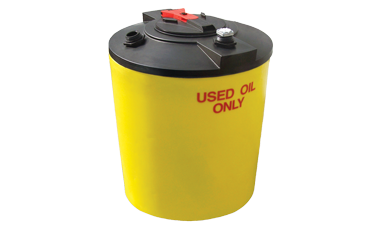 |
Used oil generators include all persons who produce used oil through commercial or industrial operations and vehicle services. The regulations exempt household “do-it-yourselfers,” farmers under certain conditions, vessels at sea or at port, and mixtures of used oil and diesel fuel under certain conditions.
If used oil is mixed with hazardous waste, it must be managed as hazardous waste unless the hazardous waste does not exhibit a characteristic waste or if the waste is generated by a conditionally exempt small quantity generator (CESQG).
Note: Because EPA’s used oil standards (40 CFR 279) have no exemption for generators based on used oil generation rate, generators that are CESQGs in terms of hazardous waste generation are subject to the used oil regulations if they generate used oil.
Attend the SPCC Compliance for Aboveground Storage Tanks webinar on March 25 to ensure your tanks and SPCC plan are in compliance. Learn more.
AST Storage Tips
- Choose the appropriate storage unit. Used oil generators may only store used oil in tanks (including USTs and ASTs), containers, or units regulated under hazardous waste treatment storage and disposal facilities (TSDF) rules (see 40 CFR 264 and 40 CFR 265). However, this does not mean that the tanks or containers must meet the respective container and tank TSDF requirements, just that storage in those regulated containers and tanks is allowed. If used oil is stored in any other type of TSDF unit (e.g., a surface impoundment, waste pile, or lagoon), the unit must be a permitted hazardous waste unit. The determination as to which storage units must be used for mixtures of used oil and hazardous waste is based on whether the used oil mixture is to be managed as used oil or as hazardous waste.
- Mark the AST clearly. Used oil ASTs and fill pipes used to transfer used oil into underground storage facilities must be clearly marked with the phrase USED OIL.
- Maintain the integrity of the tank. Used oil ASTs must not be leaking, bulging, rusting, damaged, or dented. Fix any structural defects immediately.
Note: Underground storage tanks (USTs) storing used oil are subject to the applicable UST standards in 40 CFR 280.
SPCC Compliance for Aboveground Storage Tanks: Best Practices for Handling, Inspection, Maintenance, and Operation
Join us March 25 to learn best practices for keeping your ASTs compliant and leak-free. Register now!
Additional AST requirements for Used Oil Burners
Under 40 CFR 279, “used oil burners” are defined as generators that burn off-specification used oil for energy recovery, except those that burn used oil in on-site space heaters under certain conditions. (Note: Used oil processors/rerefiners that burn used oil for processing are also exempt from these additional requirements.)
In addition to the requirements for used oil generators, used oil ASTs at used oil burners must have an impervious secondary system that consists of, at a minimum:
- Dikes, berms, or retaining walls; and
- A floor that covers the entire area within the dikes, berms, or retaining walls; or
- An equivalent secondary containment system.
